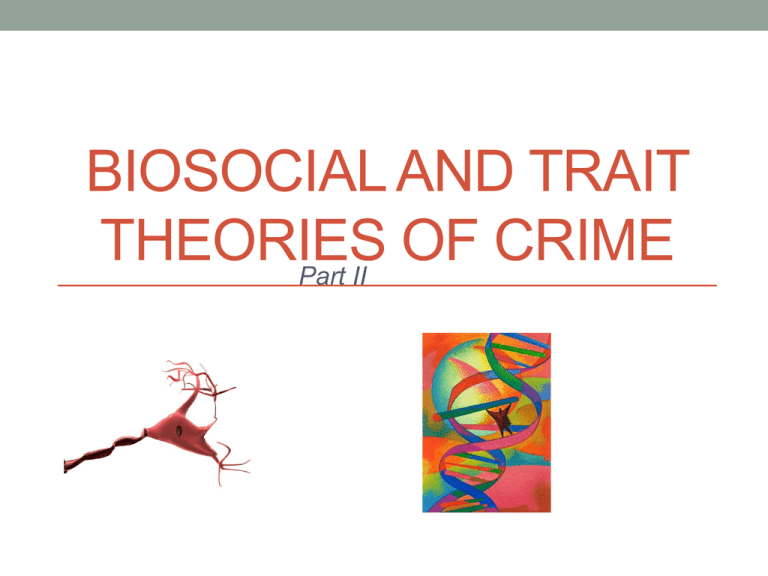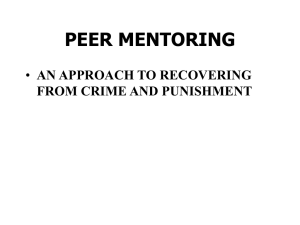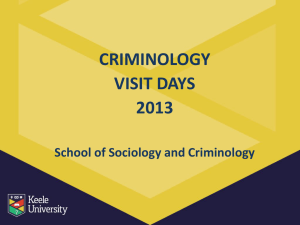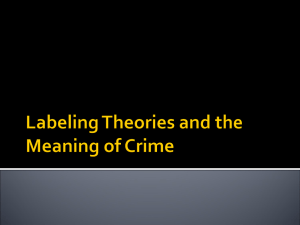
BIOSOCIAL AND TRAIT
THEORIES
OF
CRIME
Part II
The Impact of Cesare Lombroso
• Lombroso’s perspective was the dominant theory in the early 1900s
• Argued criminals were less evolved than noncriminals
• Throwbacks to our ancestors
• However, this perspective and other biological theories were soon
discredited and abandoned
Sociological Theories of Crime and
Deviance
• After biological theories were discredited, sociological
theories began to dominate the field
• Remain dominant today
• Differences in the social environment explain crime
• Family, school, peer group, community
• Argue there are no individual differences between
criminals and noncriminals
Reemergence of Individual-Level
Theories
• Criminologists have begun to criticize the exclusive focus
on social environments
• Focus on individual differences and the influence of these
differences on the likelihood of crime
Reemergence of Individual- Level
Theories
•
Much more sophisticated than Lombroso in three ways:
1.
Focus on a broader range of biological factors
•
2.
Argue these traits do not directly lead to crime but contribute to
crime
•
3.
Genetic inheritance and “biological harms”
Rather, they affect the central and autonomous nervous systems
Recognize that the social environment influences whether or not
the biological factors lead to the development of certain traits
and whether or not these traits lead to crime
The Importance of Examining
Individual/Biological Factors
•
Two main reasons to examine biological factors:
1. Biological factors can interact with the social environment to
produce crime
•
Influence how individuals respond to their environment
•
Individuals may respond to same environment differently
Individual traits may influence the social environment in
ways that may increase the likelihood of crime
2.
•
May evoke responses from others and/or seek out risky
peers/situations
•
Failure to consider biological factors and individual traits may
result in inaccurate estimates of the effect of social factors on
crime
Modern-Day Biological Theories –
Biosocial
• Due to the importance of both the social environment and
biology, modern work on biology and crime are called
biosocial
• Biosocial theorists argue that sociological theories of
crime would benefit from consideration of biological
factors and individual traits
• For example, irritability and intelligence can influence the extent a
person is exposed to strain
Modern-Day Biological Theories –
Biosocial
•
At the most general level, modern-day biological theories argue:
1. Biological and environmental factors influence
the development of traits conducive to crime
2. Traits conducive to crime influence the social
environment in ways that increase the likelihood
of crime
3. Crime is most likely among individuals who
possess traits conducive to crime and are in
aversive environments
Modern-Day Biological Theories –
Biosocial
• Glueck and Glueck examined the impact of biological,
sociological, and social factors in the explanation of crime
• Sought to explain why people respond to different environments in
different ways
• Took a life-course approach examining how the causes of crime
develop from childhood to adulthood
Glueck and Glueck: Unraveling Juvenile
Delinquency
• Glueck and Glueck examined a (1950) matched sample
of 500 delinquent and 500 nondelinquent boys
• White males ages 10 to 17 matched on age, race, neighborhood
characteristics, and intelligence
• Delinquents from two juvenile reformatories in Massachusetts
and nondelinquents from Boston public schools
• The Glueck’s followed up with the boys at ages 25 and 32
• Sutherland attacked this work, saying it was a theoretical and
downplayed sociological factors
• Sociologists rejected the work, saying it was flawed
methodologically and portrayed offenders as biologically deficient
Glueck and Glueck: Unraveling Juvenile
Delinquency
•
Argued we needed a multidisciplinary study of
crime
•
Should focus on a variety of factors that could cause
crime, unlike sociologic research
•
Sociological reasoning on the causes of crime assumes
that the mass social stimulus to behavior is alone or is the
primary significant causal force
•
This ignores two facts:
1. In every society, there are individuals who do not conform to the
laws
2. Differences exist in the responses of various individuals or
classes of persons to many of the elements in a culture-complex
of a region
Glueck and Glueck: Unraveling Juvenile
Delinquency
• Argued that area-studies (e.g., social disorganization research)
establish a region of economic and cultural disorganization that
tend to have a criminogenic effect on people, but these studies fail
to emphasize that this influence affects only a selected group of
people and not all the residents in that area
• Do not explain why the criminogenic influences of these areas fail
to turn the majority of its boys into persistent delinquents
• Argue the varieties of the physical, mental, and social history of
different people must determine the way in which people are
impacted by their social environment
• Failure to examine these factors leads to an incomplete explanation of
crime
Glueck and Glueck: Unraveling Juvenile
Delinquency
• Argued many theories of their time were focused on a
single factor (e.g., poverty) and thus were not able to
thoroughly explain crime
• There is a need for a multifactor or eclectic approach to
the study of crime causation
• Examined a variety of factors to see which ones were related to
crime
Glueck and Glueck: Unraveling Juvenile
Delinquency
• Factors with probable causal significance
• Physique
• High incidence of mesomorphic (muscular, solid) dominance in
delinquents
• Among nondelinquents, there is a high incidence of ectomorphic (linear,
thin) dominance
• Delinquents have been reported to have been restless as children as
well
Glueck and Glueck: Unraveling Juvenile
Delinquency
• Factors with probable causal significance
• Temperamental traits and emotional dynamics
• Delinquents found to be more extroversive, more vivacious, more
emotionally labile or impulsive, more destructive/sadistic, more
aggressive, and more adventurous
• Also delinquents found to be more hostile, defiant, resentful, destructive,
and suspicious than nondelinquents
• Delinquents are shown to be higher on social assertiveness, feelings of
not being recognized/appreciated, narcissism, and are less
conventional, cooperative, inclined to meet expectations of others, and
submissive to authority
• Delinquents are more stubborn and egocentric, less critical of
themselves, less conscientious, and more likely to experience conflicts
• Delinquents are more likely to handle conflicts through extroversion
Glueck and Glueck: Unraveling Juvenile
Delinquency
• Factors with probable causal significance
• Intellectual traits
• The boys were matched on intelligence, but differences were
still seen
• Delinquents are distinguished from nondelinquents in having a lesser
capacity to approach problems methodically
• Delinquents have less verbal intelligence
• Delinquents tend to express themselves intellectually in a direct,
immediate, and concrete manner rather than through
the
use of intermediate symbols or abstractions
• Delinquents have greater emotional disharmony
with their performance of intellectual
connected
tasks
Glueck and Glueck: Unraveling Juvenile
Delinquency
• Behavior reflecting significant traits
• School attainment
• May reflect temperamental and intellectual differences or
variations in early environment and training
• School accomplishment of delinquents was definitely inferior to that
of the control group
• Delinquents had a poorer attitude toward school
• Markedly disliked school and few expressed a desire to continue
their schooling
• Less interested in academic tasks, less attentive,
more
often tardy, less reliable, more careless
with their
work, lazier, more restless, less
truthful, and
sought attention
Glueck and Glueck: Unraveling Juvenile
Delinquency
• Behavior reflecting significant traits
• School misbehavior
• Delinquents misbehave at a much higher rate than nondelinquents
• Average age at first school misbehavior was 9½ (fourth grade)
• That is 3 years younger than nondelinquents who misbehaved in
school
• Engage in truancy, disobedience,
disorderliness,
stubbornness, impudence,
quarrelsome, cruelty, and
the
destruction of school property
Glueck and Glueck: Unraveling Juvenile
Delinquency
• Behavior reflecting significant traits
• General misbehavior tendencies
• Outside of school, delinquents stole rides, hopped on trucks, committed
destructive mischief, set fires, and would sneak into theaters without paying, run
away from home, bunk out, keep late hours, gamble, beg, and smoke and drink
at an early age more than nondelinquents
• Leisure time and companions
• Delinquents spent more time away from home
• More likely to play in distant neighborhoods, hang around
corners, vacant lots, waterfronts, railroad yards,
poolrooms
• Engaged in fewer supervised activities
• Gravitated to more adventurous activities
• Preferred to associate with delinquent peers
• One half of them were in gangs
street
and
Glueck and Glueck: Unraveling Juvenile
Delinquency
• Behavior reflecting significant traits
• Socio-cultural factors
• Modern culture is highly complex and ill-defined because of
conflicting values
• Must learn to be adaptive, have self-control and self-
management, learn to choose among alternative values and
to postpone immediate satisfactions for future ones
• Basic desires of adolescents similar and imperative
• Striving for happiness and for expression of a desire for freedom from
restraint, thirst for new experiences, need for security, affectional
warmth from others, and a desire to achieve success
Glueck and Glueck: Unraveling Juvenile
Delinquency
• Behavior reflecting significant traits
• Socio-cultural factors
• Home conditions of youth can facilitate or hamper the process
of internalization of authority, the taming and sublimation of
primitive impulses, and the definitions of standards of what is
good and bad
• The biosocial legacy of the parents of delinquents was consistently
poorer than that of the nondelinquents
• Greater incidence of emotional disturbances, mental retardation,
alcoholism, and criminalism among the families of the mothers of
delinquents
• Also see more emotional disturbance and criminalism
among the families of the fathers of the delinquents
Glueck and Glueck: Unraveling Juvenile
Delinquency
• Behavior reflecting significant traits
• Socio-cultural factors
• Higher proportion of delinquents’ parents suffered from serious physical
ailments and were mentally retarded, emotionally disturbed, alcoholic
• Many had a history of delinquency
• Many had poorer hygienic and moral climates
• A higher proportion of delinquents’ parents had no more than a grade-
school education, unhappy marriages, and broken homes
• Many delinquents had “substitute” parents and shifted from house to
house
• Delinquents’ parents had a more scattered work history and less planful
management of money
Glueck and Glueck: Unraveling Juvenile
Delinquency
• Behavior reflecting significant traits
• Socio-cultural factors
• Parents of delinquents were extremely harsh and lax in their
discipline
• Often neglectful
• Delinquents’ families were more disorganized, lacked warmth
and respect toward their members, were more hostile, and
had less attachment among their members
• Thus, the delinquent boys were never adequately socialized
and developed persistent antisocial tendencies
Glueck and Glueck: Unraveling Juvenile
Delinquency
• Overall, found delinquency results from the interplay
between somatic (physique—mesomorphic),
temperamental (restless and aggressive), attitudinal
(hostile and defiant), psychological (less methodical),
intellectual, and sociocultural (especially family)
forces
• Assigns special importance to biological and psychological
factors while discounting the importance of social factors
• Argue that social factors are important but do not have a causal effect
• Rather, these factors are another reflection of individual traits and early
family problems that cause delinquency
Glueck and Glueck: Unraveling Juvenile
Delinquency
The Glueck’s work showed the importance of highlighting the
differences between delinquents and nondelinquents
•
This research had three important contributions:
1. Embraced a multifactor approach where the causes of crime
were driven by the data
2. Showed early antisocial behavior was related to later
criminal behavior and thus criminal involvement was
a dynamic developmental process
• Need to examine childhood and theories that are
incomplete
• Criminological theory should become largely
a branch of developmental criminology
3. Showed antisocial youths not only are shaped by their
circumstances but also impact the social world
•
Genetic Influences on Crime
• Attempt to measure the extent that crime is inherited by
using:
• Twin studies
• Compare identical (MZ) to fraternal (DZ) twins
• MZ twins are 100% genetically similar; DZ twins are 50%
genetically similar
• Adoption studies
• Focus on children separated from family
early in life
• Molecular genetic studies
• Genes may be related to traits conducive
to crime (e.g., hyperactivity, impulsivity)
Genetic Influences on Crime
• Existing research shows that there is evidence for
some genetic basis for crime
• Twenty percent of adopted children with criminal
biological parents were criminal compared to only 13.5
percent of adoptees with noncriminal biological and
noncriminal adoptive parents
• Crime most likely when both biological and
adoptive parents were criminal
• However, genetic factors may be
most relevant to life-course-persistent
offenders and less relevant to
adolescence-limited offenders
Ellis and Walsh: “Gene-Based Evolutionary
Theories in Criminology”
• Genes have an effect on traits conducive to
crime and under some conditions
individuals with these traits might reproduce
at high rates
• Genes promoting traits of pushiness and
deception (cheating) may reproduce at high
rates passing on these genes
• Role of kin selection
Ellis and Walsh: “Gene-Based Evolutionary
Theories in Criminology”
• Focus only on victimful offenses (e.g., property and violent
crimes)
• Only examines genetic influences, not genetic
determinism
Ellis and Walsh: “Gene-Based Evolutionary
Theories in Criminology”
• The ability to learn and the disposition to learn some
things more readily than others has a genetic
predisposition
• People vary in their ease with
which they learn some behavior
• These theories come out of the
Charles Darwin and
work of
Gregor Mendel
Ellis and Walsh: “Gene-Based Evolutionary
Theories in Criminology”
• Application of gene-based evolutionary theories to criminal
behavior
• Assume people are altruistic toward close genetic relatives and
those willing to reciprocate
• Assumes a significant minority of people are genetically prone to
be extremely deceptive and prone to take advantage of others
Ellis and Walsh: “Gene-Based Evolutionary
Theories in Criminology”
•
Five specific gene-based evolutionary theories
discussed
•
Can be divided into two types:
1.
Those focused on specific crimes (e.g., rape, spousal assault,
child abuse)
2.
Those that can be applied generally to
criminal and antisocial behavior
Ellis and Walsh: “Gene-Based Evolutionary
Theories in Criminology”
(Rape and Sexual Assault)
• Assert sexual aggression is naturally selected to be
exhibited predominately by the sex that invests the
least in offspring
• Most often males
• Due to being free of parenting responsibilities, have more to
gain by having multiple sex partners
• Gain these partners by:
• Genes promoting pushiness (and sometimes force)
• Thus this gene gets passed on because
higher reproductive rates
Ellis and Walsh: “Gene-Based Evolutionary
Theories in Criminology”
(Rape and Sexual Assault)
•
Six hypotheses:
Males should predominate in the commission of rape and
sexual assault
1.
•
Men gain more from becoming pushy about sex than women
•
Males, in fact, do commit more sexual assaults/rapes than
women
Sexual assaults should not be exclusively a human
phenomenon; males of other species should have
evolved similar genetically promoted tendencies
2.
•
See rape in various nonhuman species with
males almost exclusively the offender
Ellis and Walsh: “Gene-Based Evolutionary
Theories in Criminology”
(Rape and Sexual Assault)
Rape should be strongly resisted by female victims because it denies
them the opportunity to choose sex partners who are most likely to
help care for offspring
3.
•
4.
Females are more cautious in choosing partners than males and
interested in traits of loyalty and commitment
Victims of sexual assault should primarily be females of reproductive
age
Ellis and Walsh: “Gene-Based Evolutionary
Theories in Criminology”
(Rape and Sexual Assault)
In some societies, males who engage in forced copulations
may not only reproduce relatively well, they could even outreproduce males who only mate with voluntary sex partners
5.
•
Rapists have more active sex lives
Penalties for rape will be severe to prevent genes conducive
to rape from overtaking a population
6.
•
Decision to act out is subject to environmental influences
•
Many would-be rapists are deterred
•
Wartime rape
Ellis and Walsh: “Gene-Based Evolutionary Theories
in Criminology”
(Spousal and Romantic Triangle Assault)
•
Six hypotheses:
Males should be the main offenders in cases of spousal assaults
and romantic triangle assaults
1.
•
Males are far more abusive toward spouses/girlfriends
Jealousy and suspicion of infidelity should be a key cause of
spousal and dating assaults
2.
•
Males more likely to be the abuser
•
Cuckoldry
•
Used to maintain mate’s fidelity
Ellis and Walsh: “Gene-Based Evolutionary Theories
in Criminology”
(Spousal and Romantic Triangle Assault)
“Spousal assaults” should not be an exclusively human
phenomenon
3.
•
Males from at least four other primate species have been shown to
attack females who show interest in other males or are not sexually
receptive
Spousal assault should be highest in human populations
that have fewer stable marriages, greater promiscuous
sexual intercourse, and more children who do not receive
the family name of the father
4.
•
No scientific evidence for this
Ellis and Walsh: “Gene-Based Evolutionary Theories
in Criminology”
(Spousal and Romantic Triangle Assault)
Spousal assault may prevent infidelity and/or pregnancy
resulting from infidelity
5.
•
Victims may be frightened, and so they avoid activities that provoke
assaults (trauma-induced bonding and dependency)
•
Leads to severe emotional distress that could disrupt reproductive
functioning
Women who become pregnant as a result of
sexual infidelity may be subjected to such severe
badgering by the men with whom they live with
that their pregnancy may be aborted
5.
•
No evidence among married women
Ellis and Walsh: “Gene-Based Evolutionary Theories
in Criminology”
(Child Abuse and Neglect)
•
Four hypotheses:
Parents who have more children than they have
resources needed to rear them should abuse and even
abandon their children more than parents who have
sufficient resources
1.
•
Find higher rates of abuse in larger and poorer families
A parent who lacks the assistance of the other parent in
caring for the offspring should be more prone to child
abuse, neglect, and abandonment
2.
•
Abuse unusually common among never
separated, or divorced families
married,
Ellis and Walsh: “Gene-Based Evolutionary Theories
in Criminology”
(Child Abuse and Neglect)
Children who are less viable from a reproductive standpoint are
likely to experience more abuse and neglect from parents
3.
•
Children with serious physical and mental handicaps typically
receive less care and more abuse
Children will be subjected to more abuse/neglect when no close
genetic relationship exists between the parent and the guardian
4.
•
Research has supported this
Ellis and Walsh: “Gene-Based Evolutionary Theories
in Criminology”
(Cad v. Dad)
• Females prefer men who are willing to help them care for offspring
• Some men (cads) have evolved with genes that incline them
toward an extremely low parental investment reproductive strategy
• To be favored in mating, these men must be deceptive/stealthy
• Criminals will be deceptive, irresponsible, and opportunistic in
almost everything they do
• Use devious techniques for acquiring resources
quickly and for gaining sexual access through
almost any means that work
Ellis and Walsh: “Gene-Based Evolutionary Theories
in Criminology”
(Cad v. Dad)
•
Five hypotheses:
Criminality and psychopathy should be more prevalent among
men than among women
1.
•
Support for this found in all societies studied and, especially, with
severe and persistent offending
Criminals and psychopaths should be
unusually promiscuous
2.
•
Several studies have shown criminality
and psychopathy are associated with an early
onset of promiscuous sexual behavior
Ellis and Walsh: “Gene-Based Evolutionary Theories
in Criminology”
(Cad v. Dad)
Criminals and psychopaths should be more inclined to
commit sexual assaults than males in general
3.
•
Evidence is generally supportive of this
•
Rapists are generally not specialists but rather exhibit all of the
other major criminal and antisocial behavioral traits
The cad strategy should be more pronounced among
males in the prime of their reproductive careers than in
later life
4.
•
Ontogenetic shift
•
Burnout later in life
Ellis and Walsh: “Gene-Based Evolutionary Theories
in Criminology”
(Cad v. Dad)
The cheater strategy should be more prevalent in the lower than
the upper social strata
5.
•
Two subpopulations of males have formed:
1.
Those who can provide
•
2.
More attractive to females
Those who cannot provide
•
More inclined to mate opportunistically
and be a cad
Ellis and Walsh: “Gene-Based Evolutionary Theories
in Criminology”
(r/K Theory)
• r/K continuum
R
K
Mating
Parenting
• Organisms reproduce rapidly and
prolifically whenever environmental
opportunities allow
• Organisms reproduce slowly and
cautiously even when environmental
opportunities allow
• Do not invest much
time/resources in their offspring
• Invest a great deal of
time/resources in their offspring
• Begin reproducing at earlier age
• Often have numerous offspring
Ellis and Walsh: “Gene-Based Evolutionary Theories
in Criminology”
(r/K Theory)
•
Four hypotheses:
1.
Criminality and psychopathy should be more prevalent among
men than among women
2.
Persons with the greatest tendencies toward criminal/antisocial
behaviors should exhibit at least most of the psychological traits
associated with an r strategy
•
Low birth weight, premature birth, frequent twinning
Ellis and Walsh: “Gene-Based Evolutionary Theories
in Criminology”
(r/K Theory)
Parents of criminals and psychopaths should begin having
children earlier in life and should have larger numbers of
children in general
3.
•
Evidence for this exists
Biological parents of criminals and psychopaths should
themselves be criminal and psychopathic
4.
•
Evidence for this is substantial
Modern Day Gene-Based Evolutionary
Theories
• Ultimate causes
• Natural selection forces that have favored genes for various
combinations of traits, both physical and behavioral
• Proximate causes
• Pertain to detailed physiological events that mediate genetic effects
on behavior
• Testosterone, MAOs, serotonin, alcoholism
Modern Day Gene-Based Evolutionary
Theories
• Overall, these modern day gene-based theories are much
more advanced than Lombroso’s theories
• Criminal behavior seen as being an adaptation to life in a large
impersonal society
• However,
learning still
important
• But it is highly influenced
by genes
“Biological Harms” and Crime
• Crime is also affected by nongenetic biological factors
• Mother’s poor health habits during pregnancy
• Delivery complications
• Exposure to toxic substances (e.g., lead)
• Head injury
Central and Autonomic Nervous System
and Crime
• Central: controls brain and spinal cord
• Autonomic: heart rate, gland secretion, emotional
reaction to stimuli
• Frontal lobe damage can lead to:
• Hyperactivity, impulsivity, irritability, reduced ability to
learn from punishment, lower empathy, difficulty problem solving
• Criminals show less emotional response to stimuli
• Psychologically drowsy
• Lower skin conductance, lower resting heart rate, slower alpha
brain waves
Central and Autonomic Nervous System and
Crime (Rowe)
• Genetic factors and biological harms affect individual traits
through their impact on the central nervous system (CNS)
and autonomic nervous system (ANS)
Peskin et al.: “Biology and Crime”
• Show the following major conclusions concerning biology and
crime
• Genetic factors and biological harms affect individual traits through
their impact on the structure and functioning of the brain and the
autonomic nervous system
• Genetic studies show considerable heritability estimates for criminal
behavior, and molecular genetics research focuses on identifying
candidate genes for antisocial behavior
• Functional and structural neuroimaging studies found deficits in frontal,
temporal, and subcortical brain regions in criminal and antisocial
populations
• Neuropsychological research has shown criminals have deficits in
verbal, spatial, and executive abilities
Peskin et al.: “Biology and Crime”
• Show the following major conclusions concerning biology and
crime
• Psychophysiological research has uncovered predictors of later
criminal behavior in autonomic underarousal and hyporesponsivity
• Hormonal research suggests and imbalance between hormones
involved in the fear/stress response and in the rewardseeking/dominant behavior may contribute to phenotypic traits seen in
antisocial people
• Serotonin has been implicated in aggressive behavior
• Early health risk factors (e.g., prenatal nicotine/alcohol exposure, birth
complications, minor physical anomalies) increase the risk of antisocial
and criminal behavior throughout life
Peskin et al.: “Biology and Crime”
• Argue there are six domains of neurobiological research
showing a relationship between biological risk factors and
crime
1.
2.
3.
4.
5.
6.
Genetics
Neuroimaging
Neuropsychology
Psychophysiology
Endocrinology and
Early health risk factors
neurotransmitters
Peskin et al.: “Biology and Crime”
• Genetics
• Using twin studies, adoptive studies, studies of twins reared apart,
and molecular genetic studies, heritability estimates in the 40–60%
range have been found for antisocial behavior
• Sample age moderates this estimate with lower heritability and higher
shared environmental influences on antisocial behavior in childhood
than adulthood
• Genetic influences on criminality tend to rise with age while shared
environmental effects decline with age
• Antisocial behavior beginning early in life and persists in more heritable than
antisocial behavior restricted to childhood
Peskin et al.: “Biology and Crime”
• Genetics
• Type of offending moderates the genetic effect
• Aggressive offending is more heritable than nonaggressive behavior
• Nonaggressive behavior more influenced by shared environmental
factors (e.g., family criminality, family poverty, poor parenting)
• Multiple genes are involved in the vulnerability for crime and the
interaction of genes and the environment is important in the
etiology of criminal behavior
Peskin et al.: “Biology and Crime”
• Neuroimaging
• Fronto-temporal gray matter volume reductions associated with
antisocial behavior
• Reduced hippocampal and parahippocampal gray volumes in
schizophrenic murderers compared to nonviolent schizophrenics
and healthy controls
• Disrupted amygdala-orbitofrontal connections in psychopaths with
convictions
• Proposed the amygdala, with its importance in fear conditioning,
and the hippocampus, with its importance in emotional memory,
temporal lobe damage may predispose to a lack of fear for
punishment and result in the disruption of normal moral
development
Peskin et al.: “Biology and Crime”
• Criminals have also been shown to have reduced glucose
metabolism, reduced blood flow, reduced activation in
prefrontal, orbitofrontal, temporal, and parietal cortices
• Criminals show increased brain activity to threat stimuli
and disturbances in the dopamine reward system
• Impairment to frontal, temporal, and subcortical may lead
to difficulties in moral socialization, behavioral inhibition,
emotion regulation, and fear conditioning
Peskin et al.: “Biology and Crime”
• Neuropsychology
• Intelligence
• Antisocial behavior and low IQ have been found to have a common
genetic basis
• Decreased verbal IQ, compared to performance IQ, has been found to
be associated with criminal behavior, especially in adolescence
• One explanation is that lower verbal IQ could result in
underachievement in school which results in antisocial behavior
• Another explanation could be that antisocial behavior in school leads to
school refusal and gaps in education and produces low verbal IQ
• Further, low verbal IQ could lead to socialization failure
Peskin et al.: “Biology and Crime”
• Neuropsychology
• Executive functioning
• Includes cognitive processes such as mental flexibility, strategy
formation, selective attention, and suppression of habitual responses
• Controlled by the prefrontal cortex
• Antisocial populations have impaired
scores on executive
functioning
• Found across all age groups, with males and females, and with violent
offending
Peskin et al.: “Biology and Crime”
• Psychophysiology
• Includes skin conductance, heart rate, electroencephalography,
and event-related potentials
• Reduced classical fear conditioning is related to criminal behavior –
may result in a lack of conscience
• Poor skin conductance is associated with antisocial behavior
• High autonomic arousal associated with desistance
Peskin et al.: “Biology and Crime”
• Psychophysiology
• Low resting heart rate associated with child and adolescent
antisocial behavior; high resting heart rate is associated with
desistence
• Greater heart reactivity is seen in conduct disordered children
• Arousal levels are consistently lower in criminals than noncriminals
• Low heart rates, low skin conductance, and low arousal do
generate somatic markers associated with antisocial behavior
Peskin et al.: “Biology and Crime”
• Psychophysiology
• More slow-wave EEG (underarousal) in frontal and temporal
regions and atypical frontal asymmetry of brain is associated with
antisocial behavior
• Impairs inhibitory control, predisposes to sensation seeking, abnormal
emotional reactions and affective styles
• P300 deficits associated with inefficient cognitive processes, drug
abuse, child conduct disorder, ADHD
Peskin et al.: “Biology and Crime”
• Hormones and Neurotransmitters
• Hormonal imbalances
• Cortisol is the body’s stress hormone
• Low levels associated with antisocial children and adolescents and violent and
psychopathic adults
• Testosterone
• Associated with aggressive behavior in adults
• May help explain gender differences in criminal behavior
• Also linked with social dominance
Peskin et al.: “Biology and Crime”
• Hormones and Neurotransmitters
• Neurotransmitter dysfunction
• Reduced serotonin levels are related to aggressive behavior, especially
crimes that harm others such as arson and homicide
Peskin et al.: “Biology and Crime”
• Early Health Risks
• Smoking during pregnancy
• Predicts conduct disorder, delinquency, and adult criminal and violent
offending
• Dose-response relationship
• Alcohol use during pregnancy
• Associated with fetal alcohol syndrome (FAS)
• Prenatal exposure associated overrepresentation in juvenile justice
system
Peskin et al.: “Biology and Crime”
• Early Health Risks
• Birth complications
• Includes premature birth, low birth weight, placement in NICU, forceps
delivery, C-section, anoxia, preeclampsia
• Believed to directly and indirectly impact brain development
• Often interact with psychosocial factors predicting antisocial behavior, conduct
disorder, delinquency, and impulsive crime and violence
Peskin et al.: “Biology and Crime”
• Early Health Risks
• Minor physical anomalies (MPAs)
• Biomarker for fetal neural maldevelopment during first and second
trimesters
• Curved fifth finger, furrowed tongue, single palmer crease, low-seated ears
• Association between MPAs and delinquency and violent behavior in children
and adults
• Interact with social factors in predisposing to violent and criminal behavior
• Being raised in a stable, intact family moderated the relationship between MPAs and
violent crime with MPAs predicting violent crime for those in unstable homes
Environmental Influences on Traits
• Traits are also influenced by the social environment
• Socialization efforts of parents
• Adversity of environment
• Biological harms may be a function of the social
environment
• More likely to be exposed to toxins, poor prenatal care,
poverty, and abuse
• Dysfunctions in the CNS and ANS can make children
more difficult to parent
• Combination of biological factors and poor social
environment make criminal behavior more likely than
having one alone
Individual Traits and Crime
• Traits: relatively stable ways of perceiving, thinking about, and
behaving toward the environment and oneself
• Several traits are associated with criminal behavior
• Low verbal IQ, ADHD, impulsivity, irritability, low empathy, poor
social and problem-solving skills
• People with the above traits:
• Are more likely to elicit negative responses from
others
• Sort themselves into negative environments
• Respond to mild slights with aggression
Individual Traits and Crime
• Often many traits cluster together
• Some researchers identify “super-traits” that may be
associated with criminal behavior
• Psychopathy
• Low self-control
• Verbal IQ
• Temperament
Caspi et al.: “Personality and Crime: Are
Some People Crime Prone?”
•
Personality has three super-traits
1.
Negative emotionality
•
2.
3.
•
Likely to experience events as aversive, experience intense reactions
such as anger and to respond to events with aggression
Constraint
•
If low, likely to be impulsive
•
If high, likely to endorse conventional norms, avoid thrills, and act
cautious
Positive emotionality
•
Likely to have a lower threshold for experience of positive emotions and
for positive engagement with their social and work environments
•
More likely to view life as a pleasurable experience
Measured with MPQ or CCQ
Caspi et al.: “Personality and Crime: Are
Some People Crime Prone?”
• Studied:
• People in New Zealand
• 18-year-old males and females from an entire birth cohort
• 12- and 13-year-old black and white males from the U.S.
Caspi et al.: “Personality and Crime: Are
Some People Crime Prone?”
• Negative emotionality and constraint were robust
correlates of delinquent behavior
• Positive emotionality was not related to criminal behavior
• Results held among individuals who engaged in serious (repeat)
criminal behavior
• Results held across males and females, whites and blacks, and
cross-nationally
Caspi et al.: “Personality and Crime: Are
Some People Crime Prone?”
• Origins of negative emotionality and constraint
• Family environment
• Harsh, inconsistent punishment
• Constant threat of physical and emotional harm
• Parental conflict
• Neurobiological underpinnings
• Serotonin
• Genetics
Interactive Effect of Biological Factors, Traits, and
the Social Environment on Crime
• “Dual hazard” prediction
• Crime is most likely when individuals who are biologically
predisposed to crime are in environments conducive to crime
• Traits can influence how people respond to the environment
or how the environment responds to the individual
• Crime is influenced by cognitive and temperamental
traits which are a function of both genetic and social
environmental factors
• Worst outcome occurs when both traits and environment are
criminogenic
Summary
• Modern-day individual trait theories are much more
advanced than the work of Lombroso
• It is important to examine the interaction of both individual
traits and the social environment when explaining the
development and maintenance of antisocial behavior










